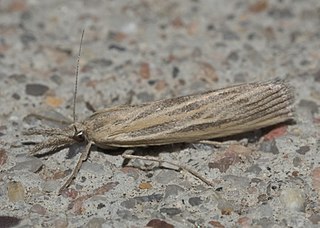Dichozoma is a monotypic moth genus of the family Crambidae erected by Eugene G. Munroe in 1961. Its only species, Dichozoma parvipicta, was first described by William Barnes and James Halliday McDunnough in 1918. It is found in North America, where it has been recorded from Arizona, California, Utah and Texas.

Thaumatopsis is a genus of moths of the family Crambidae.
Neodactria modestellus is a moth in the family Crambidae. It was described by William Barnes and James Halliday McDunnough in 1918. It is found in North America, where it has been recorded from Texas.
Pediasia ericella is a moth in the family Crambidae. It was described by William Barnes and James Halliday McDunnough in 1918. It is found in North America, where it has been recorded from California and Alberta. The habitat consists of prairies and aspen parklands.
Thaumatopsis fieldella is a moth in the family Crambidae. It was described by William Barnes and James Halliday McDunnough in 1912. It is found in North America, where it has been recorded from California.
Thaumatopsis floridella, the Floridian grass-veneer, is a moth in the family Crambidae. It was described by William Barnes and James Halliday McDunnough in 1913. It is found in North America, where it has been recorded from coastal areas in Florida, Georgia, Mississippi, South Carolina and North Carolina, New Jersey, New York, and Rhode Island. It is also found in Cuba.
Cornifrons actualis is a moth in the family Crambidae. It was described by William Barnes and James Halliday McDunnough in 1918. It is found in North America, where it has been recorded from Arizona, California, Montana, Nevada, Texas and Utah. The habitat consists of deserts.
Loxostege anartalis is a moth in the family Crambidae. It was described by Augustus Radcliffe Grote in 1878. It is found in North America, where it has been recorded from coast to coast in Canada. In the west, the range extends south to California.
Loxostege terpnalis is a moth in the family Crambidae. It was described by William Barnes and James Halliday McDunnough in 1918. It is found in North America, where it has been recorded from Nevada and California.

Pyrausta inveterascalis is a moth in the family Crambidae. It was described by William Barnes and James Halliday McDunnough in 1918. It is found in North America, where it has been recorded from western Pennsylvania to southern Ontario, Illinois and Missouri.

Pyrausta ochreicostalis is a moth in the family Crambidae. It was described by William Barnes and James Halliday McDunnough in 1918. It is found in North America, where it has been recorded from California and Nevada.
Pyrausta pythialis is a moth in the family Crambidae. It was described by William Barnes and James Halliday McDunnough in 1918. It is found in North America, where it has been recorded from Manitoba and Saskatchewan.
Pyrausta tuolumnalis is a moth in the family Crambidae. It was described by William Barnes and James Halliday McDunnough in 1918. It is found in North America, where it has been recorded from the western Northwest Territories and Yukon, south through British Columbia and Alberta to the mountains of California and New Mexico. The habitat consists of forested areas in the mountains.
Pyrausta zonalis is a moth in the family Crambidae. It was described by William Barnes and James Halliday McDunnough in 1918. It is found in North America, where it has been recorded from Texas, Arizona and California.
Cymbopteryx unilinealis is a moth in the family Crambidae. It was described by William Barnes and James Halliday McDunnough in 1918. It is found in North America, where it has been recorded from Arizona.
Noctueliopsis palmalis is a moth in the family Crambidae. It was described by William Barnes and James Halliday McDunnough in 1918. It is found in North America, where it has been recorded from California, Nevada and Texas. The habitat consists of high and low elevation deserts.
Noctueliopsis virula is a moth in the family Crambidae. It was described by William Barnes and James Halliday McDunnough in 1918. It is found in North America, where it has been recorded from Arizona, California and Nevada.
Loxostegopsis curialis is a moth in the family Crambidae. It was described by William Barnes and James Halliday McDunnough in 1918. It is found in North America, where it has been recorded from California, New Mexico, Texas and Utah.
Loxostegopsis emigralis is a moth in the family Crambidae. It was described by William Barnes and James Halliday McDunnough in 1918. It is found in North America, where it has been recorded from Arizona and Texas.
Loxostegopsis merrickalis, or Merrick's pyralid moth, is a moth in the family Crambidae. It was described by William Barnes and James Halliday McDunnough in 1918. It is found in North America, where it has been recorded from Alabama, California, Florida, Georgia, Illinois, Indiana, Kansas, Maine, Manitoba, Maryland, Massachusetts, Minnesota, New Hampshire, North Carolina, North Dakota, Ohio, Ontario, Pennsylvania, Quebec, South Carolina, Texas, West Virginia and Wisconsin.


